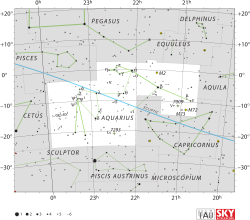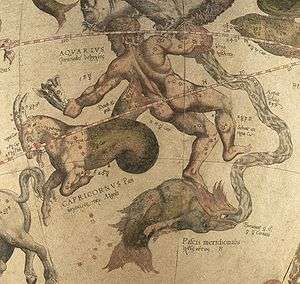Beta Aquarii

| |
| Observation data Epoch J2000 Equinox J2000 | |
|---|---|
| Constellation | Aquarius |
| Right ascension | 21h 31m 33.53171s[1] |
| Declination | –05° 34′ 16.2320″[1] |
| Apparent magnitude (V) | 2.87[2] |
| Characteristics | |
| Spectral type | G0 Ib[3] |
| U−B color index | +0.58[2] |
| B−V color index | +0.84[2] |
| Astrometry | |
| Radial velocity (Rv) | 6.5[4] km/s |
| Proper motion (μ) | RA: +18.77[1] mas/yr Dec.: –8.21[1] mas/yr |
| Parallax (π) | 6.07 ± 0.22[1] mas |
| Distance | 540 ± 20 ly (165 ± 6 pc) |
| Absolute magnitude (MV) | –3.34[5] |
| Details | |
| Mass | 6.0–6.5[6] M☉ |
| Radius | 50[7] R☉ |
| Luminosity | 2,300[6] L☉ |
| Surface gravity (log g) | 2.05[6] cgs |
| Temperature | 5,700[6] K |
| Metallicity [Fe/H] | –0.03[8] dex |
| Rotational velocity (v sin i) | 6.3 ± 1.3[9] km/s |
| Age | 60[9] Myr |
| Other designations | |
| Database references | |
| SIMBAD | data |
Beta Aquarii (β Aquarii, abbreviated Beta Aqr, β Aqr), also named Sadalsuud,[11] is a double star in the constellation of Aquarius. Based upon parallax measurements, it is located at a distance of about 540 light-years (160 parsecs) from the Sun.[1]
Nomenclature
β Aquarii (Latinised to Beta Aquarii) is the star's Bayer designation.
It bore the traditional name Sadalsuud, from an Arabic expression سعد السعود sa‘d al-su‘ūd, the "luck of lucks". Other spellings that were sometimes encountered were Sad es Saud, Sadalsund, and Saad el Sund. In the catalogue of stars in the Calendarium of Al Achsasi Al Mouakket, this star was designated Nir Saad al Saaoud, which was translated into Latin as Lucida Fortunæ Fortunarum (rather identic with R.H. Allen), meaning the brightest of luck of lucks.[12] In 2016, the International Astronomical Union organized a Working Group on Star Names (WGSN)[13] to catalogue and standardize proper names for stars. The WGSN approved the name Sadalsuud for this star on 21 August 2016 and it is now so entered in the IAU Catalog of Star Names.[11]
In Chinese, 虚宿 (Xū Sù), meaning Emptiness (asterism), refers to an asterism consisting of Beta Aquarii and Alpha Equulei.[14] Consequently, Beta Aquarii itself is known as 虛宿一 (Xū Sù yī, English: the First Star of Emptiness.)[15]
Sadalsuud is found in Hindu texts as Kalpeny and, in the context of the ancient Indian system of astronomy, Jyotisha Veda, is located in the 23rd Nakshatra Shravishthā, a lunar mansion which is ruled by Eight vasus - the "deities of earthly abundance" . On the Euphrates, Sadalsuud was known as Kakkab Nammax, the Star of Mighty Destiny; that may have given origin to the title of the manzil, as well as to the astrologers' name for it — Fortuna Fortunarum.[16]
Properties
Sadalsuud is the brightest star in Aquarius with an apparent magnitude of 2.87[2] and a stellar classification of G0 Ib.[3] Since 1943, the spectrum of this star has served as one of the stable anchor points by which other stars are classified.[17] The mass of this star is about 6.0 to 6.5 times the mass of the Sun, but it is emitting roughly 2,300 times the Sun's luminosity implying a radius that is 50 times that of the Sun.[6][7] It has an estimated age of 60 million years;[9] old enough for a star of this mass to evolve into a supergiant. The estimated effective temperature of the star's outer envelope is about 5,700 K,[6] giving it the characteristic yellow hue of G-type stars.[18]
X-ray emissions from the corona of this star have been detected using the Chandra X-ray Observatory; among the first such detections of X-rays for a G-type supergiant. A secondary X-ray source discovered near Beta Aquarii probably has an extragalactic origin.[9] This star belongs to a group of three intermediate mass stars with a space velocity that is carrying them perpendicular to the plane of the galaxy. The other members of this grouping are Alpha Aquarii and Eta Pegasi.[9]
Double star
| Parameter | Star Data | |||||||||||
|---|---|---|---|---|---|---|---|---|---|---|---|---|
| Magnitude | 11.0 | 11.6 | ||||||||||
| RA | 21h 31m 31.9s | 21h 31m 33.0s | ||||||||||
| Dec | −05° 33′ 46″ | −05° 35′ 10″ | ||||||||||
"Sadalsuud" appears to be a single star to the naked eye, but when viewed with a telescope is seen to have two faint optical companions. The first has an apparent magnitude of 11.0. In 1947, the position angle was observed at 321 degrees with a separation from the Beta Aquarii of 35.4 arcseconds.[19][20] The second star has a magnitude of 11.6. Its position angle is 186 degrees with a separation from Beta Aquarii of 57.2 arcseconds.[19][20] As of 2008, there is no definitive evidence that the three stars form a ternary star system.[21]
In Mythology

In the context of older worldviews (i.e.Egyptian, Persian and Islamic mythology), Sadalsuud relates to the rising of the Sun when winter has passed (March) and the season of gentle, continuous rain has begun.[16] Hence the myth of "luck" or "good fortune" was seen as closely aligned with the essence of spring itself, the burgeoning of new life, and by extension agriculture, which in all societies is the very foundation of prosperity or "good fortune". This mythological view of "the luck of the lucks" also belongs to the 22d Manzil (Arabic Lunar Mansion), which included the two stars Xi Aquarii (Bunda) and 46 Capricorni.[16][23]
β and ξ Aquarii also constitute the Persian lunar mansion Bunda and the similar Coptic mansion Upuineuti, the meaning of which is "the Foundation".
In Chinese mythology, β Aqr alone marks the sieu (Chinese Lunar Mansion) Heu, Hiu, or Hü, "the Void", anciently Ko, the central one of the seven sieu which, taken together, were known as Heung Wu, the Black Warrior, in the northern quarter of the sky.[16] As such, Sadalsuud is an expression of the feminine archetype, the Yin or "Void" (Cosmic Mother), from which, many cultures have believed, creation itself (birth) emanates.
References
- 1 2 3 4 5 6 van Leeuwen, F. (November 2007). "Validation of the new Hipparcos reduction". Astronomy and Astrophysics. 474 (2): 653–664. arXiv:0708.1752
 . Bibcode:2007A&A...474..653V. doi:10.1051/0004-6361:20078357.
. Bibcode:2007A&A...474..653V. doi:10.1051/0004-6361:20078357. - 1 2 3 4 Johnson, H. L.; et al. (1966). "UBVRIJKL photometry of the bright stars". Communications of the Lunar and Planetary Laboratory. 4 (99). Bibcode:1966CoLPL...4...99J.
- 1 2 Morgan, W. W.; Keenan, P. C. (1973). "Spectral Classification". Annual Review of Astronomy and Astrophysics. 11: 29. Bibcode:1973ARA&A..11...29M. doi:10.1146/annurev.aa.11.090173.000333.
- ↑ Wilson, Ralph Elmer (1953). General Catalogue of Stellar Radial Velocities. Washington: Carnegie Institution of Washington. Bibcode:1953GCRV..C......0W.
- ↑ Elgarøy, Øystein; Engvold, Oddbjørn; Lund, Niels (March 1999), "The Wilson-Bappu effect of the MgII K line - dependence on stellar temperature, activity and metallicity", Astronomy and Astrophysics, 343: 222–228, Bibcode:1999A&A...343..222E
- 1 2 3 4 5 6 Smiljanic, R.; et al. (April 2006), "CNO in evolved intermediate mass stars", Astronomy and Astrophysics, 449 (2): 655–671, arXiv:astro-ph/0511329
 , Bibcode:2006A&A...449..655S, doi:10.1051/0004-6361:20054377
, Bibcode:2006A&A...449..655S, doi:10.1051/0004-6361:20054377 - 1 2 Kaler, James B. "Sadalsuud (Beta Aquarii)". Stars. University of Illinois. Retrieved 2010-01-17.
- ↑ Soubiran, C.; et al. (2008). "Vertical distribution of Galactic disk stars. IV. AMR and AVR from clump giants". Astronomy and Astrophysics. 480 (1): 91–101. arXiv:0712.1370
 . Bibcode:2008A&A...480...91S. doi:10.1051/0004-6361:20078788.
. Bibcode:2008A&A...480...91S. doi:10.1051/0004-6361:20078788. - 1 2 3 4 5 Ayres, Thomas R.; Brown, Alexander; Harper, Graham M. (July 2005). "Chandra Observations of Coronal Emission from the Early G Supergiants α and β Aquarii". The Astrophysical Journal. 627 (1): L53–L56. Bibcode:2005ApJ...627L..53A. doi:10.1086/431977.
- ↑ "bet Aqr -- Star in double system". SIMBAD. Centre de Données astronomiques de Strasbourg. Retrieved 2010-05-17.
- 1 2 "IAU Catalog of Star Names". Retrieved 28 July 2016.
- ↑ Knobel, E. B. (June 1895). "Al Achsasi Al Mouakket, on a catalogue of stars in the Calendarium of Mohammad Al Achsasi Al Mouakket". Monthly Notices of the Royal Astronomical Society. 55: 429. Bibcode:1895MNRAS..55..429K. doi:10.1093/mnras/55.8.429.
- ↑ IAU Working Group on Star Names (WGSN), International Astronomical Union, retrieved 22 May 2016.
- ↑ (Chinese) 中國星座神話, written by 陳久金. Published by 台灣書房出版有限公司, 2005, ISBN 978-986-7332-25-7.
- ↑ (Chinese) 香港太空館 - 研究資源 - 亮星中英對照表, Hong Kong Space Museum. Accessed on line November 23, 2010.
- 1 2 3 4 Allen, Richard H. (1963). "Star Names: Their Lore and Meaning". Dover Publications. Retrieved 2010-05-17.
- ↑ Garrison, R. F. (December 1993), "Anchor Points for the MK System of Spectral Classification", Bulletin of the American Astronomical Society, 25: 1319, Bibcode:1993AAS...183.1710G, retrieved 2012-02-04
- ↑ "The Colour of Stars", Australia Telescope, Outreach and Education, Commonwealth Scientific and Industrial Research Organisation, December 21, 2004, archived from the original on 2012-03-10, retrieved 2012-01-16
- 1 2 "CCDM (Catalog of Components of Double & Multiple stars) (Dommanget+ 2002)". VizieR. Centre de Données astronomiques de Strasbourg. Retrieved 2010-05-17.
- 1 2 "Sadalsuud". Alcyone Bright Star Catalogue. Retrieved 2010-05-17.
- ↑ Eggleton, P. P.; Tokovinin, A. A. (September 2008). "A catalogue of multiplicity among bright stellar systems". Monthly Notices of the Royal Astronomical Society. 389 (2): 869–879. arXiv:0806.2878
 . Bibcode:2008MNRAS.389..869E. doi:10.1111/j.1365-2966.2008.13596.x.
. Bibcode:2008MNRAS.389..869E. doi:10.1111/j.1365-2966.2008.13596.x. - ↑ Gerard Mercator (1512-1594). "Aquarius and Capricornus constellations from the Mercator celestial globe". The Mercator Globes at Harvard Map Collection. Retrieved 2010-01-18.
- ↑ β Aqr as Nir Saad al Saaoud or Lucida Fortunæ Fortunarum (the brightest of luck of lucks) and Xi Aquarii as Thanih Saad al Saaoud or Secunda Fortunæ Fortunarum (the second of luck of lucks). 46 Capricorni should be Thalath Fortunæ Fortunarum or Tertia Fortunæ Fortunarum (the third of luck of lucks) consistently, but Al Achsasi Al Mouakket was not designated the title for this star with uncleared consideration. Possibly according to the differences of opinion with R.H.Allen
External links
- An Atlas of the Universe: Multiple Star Orbits
- Harvard Map Collection The Mercator Globes
- Image β Aquarii
Coordinates: ![]() 21h 31m 33.5341s, −05° 34′ 16.22″
21h 31m 33.5341s, −05° 34′ 16.22″